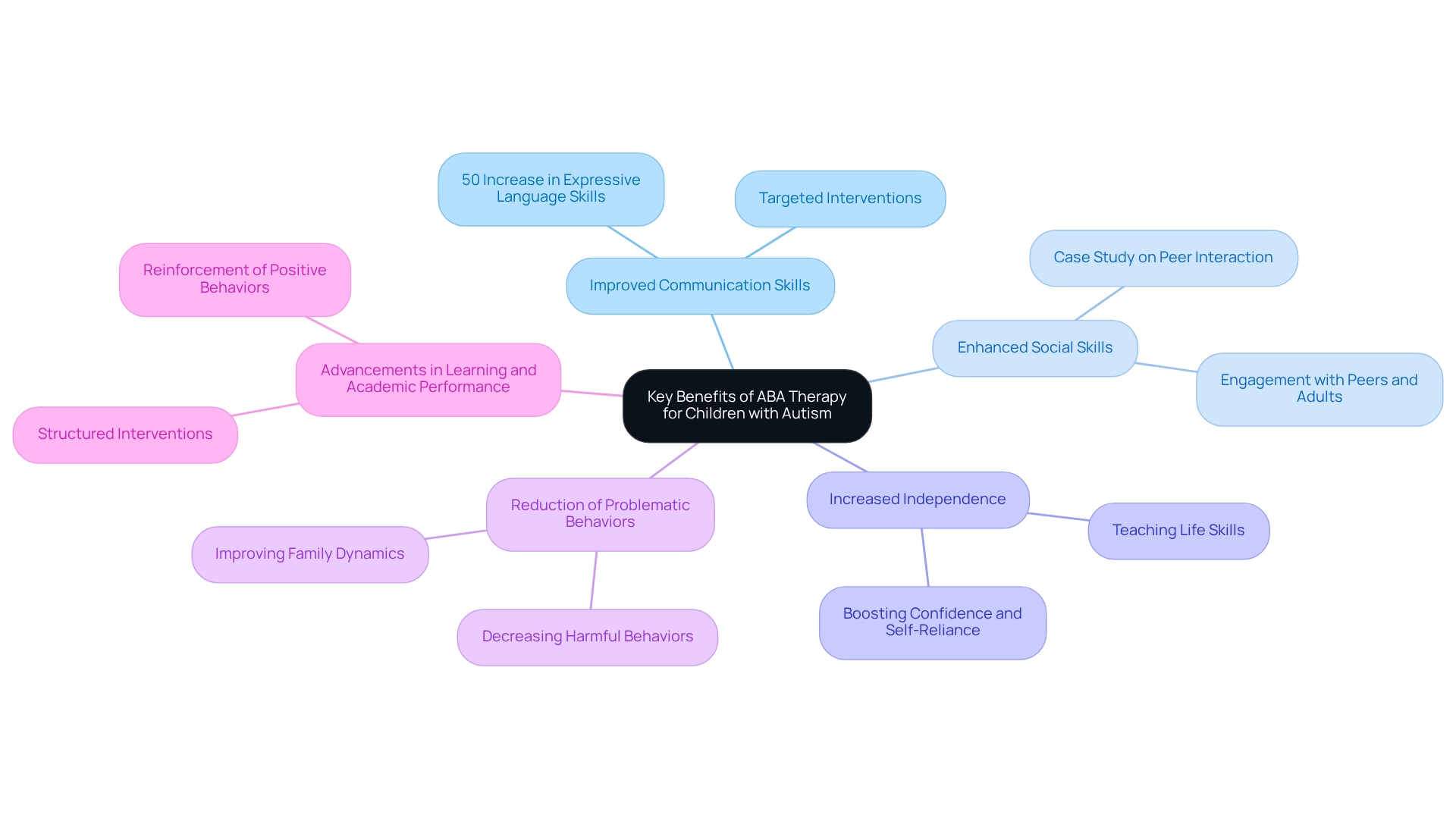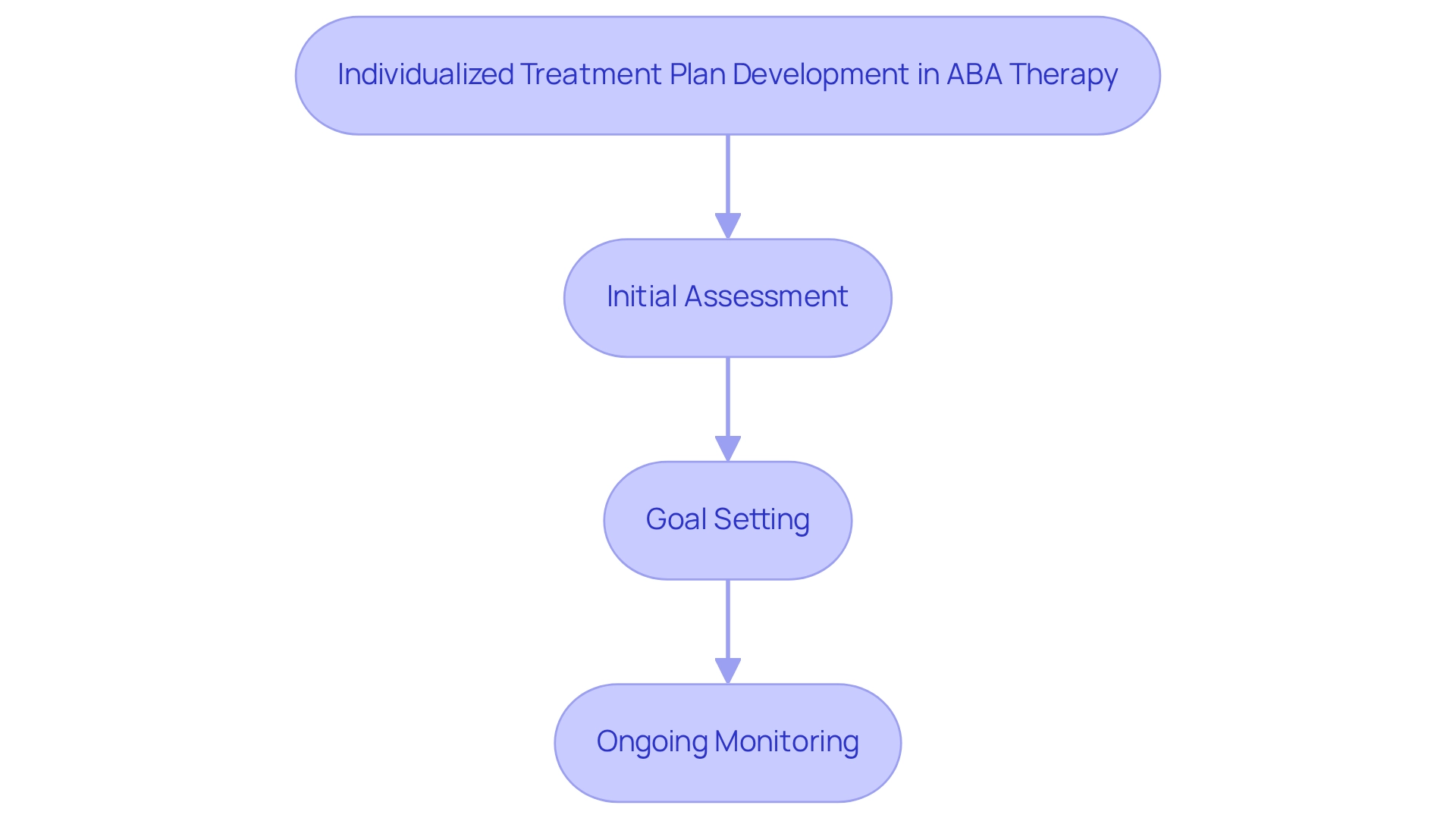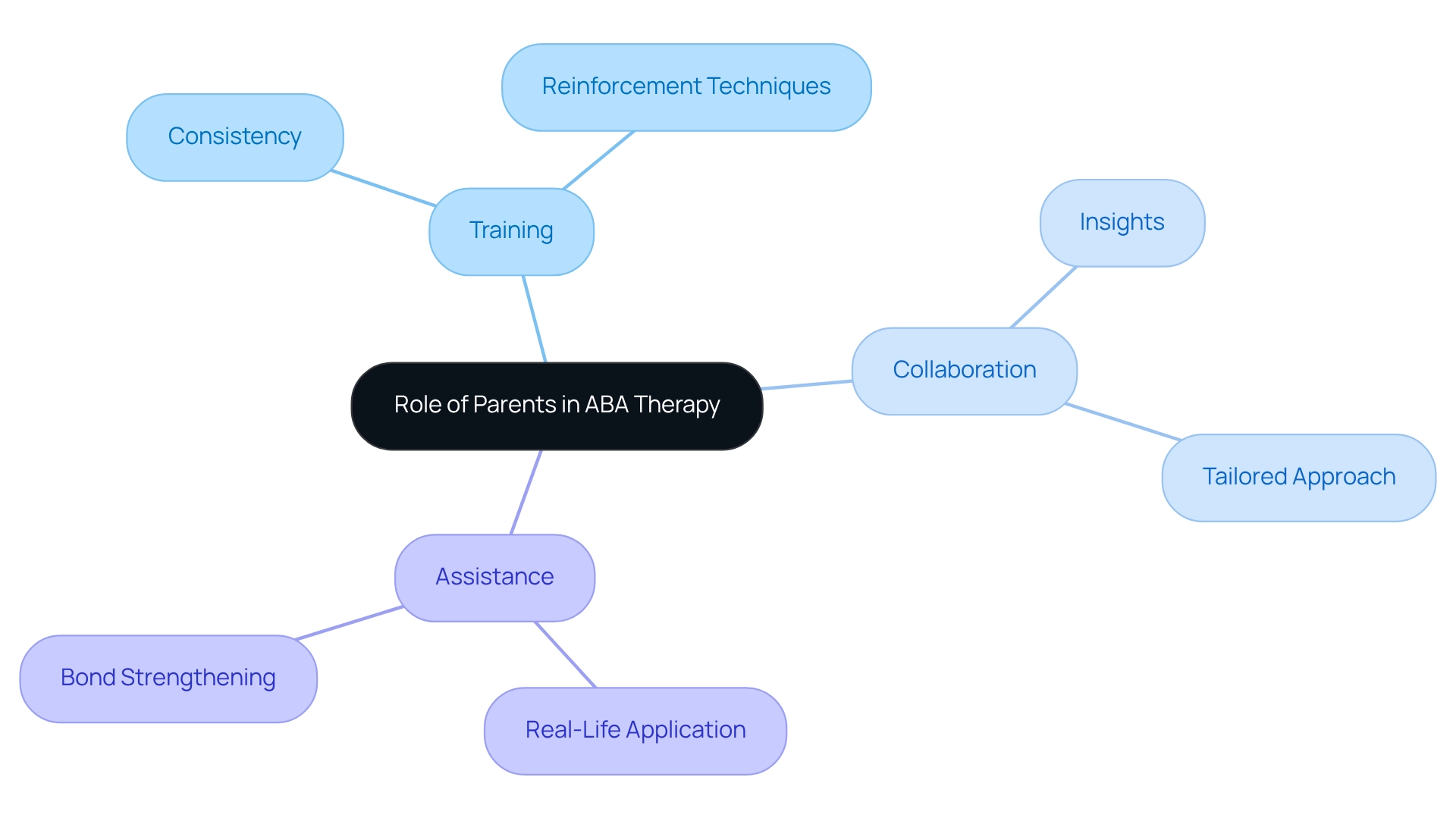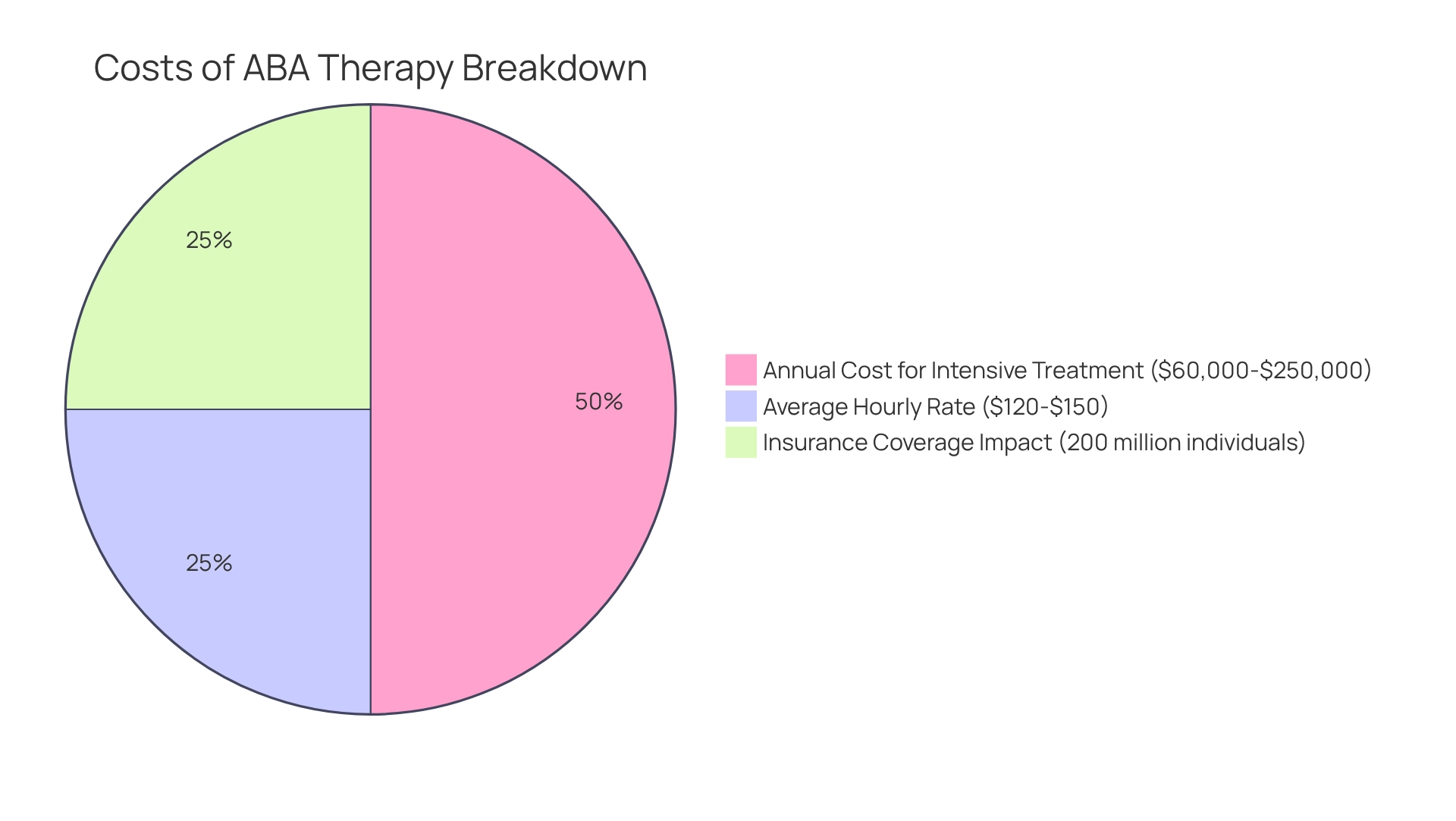Overview
This article delves into the profound benefits of Applied Behavior Analysis (ABA) therapy for children, especially those on the autism spectrum. It aims to empower parents by simplifying the complexities of this valuable treatment. ABA therapy has been shown to facilitate remarkable advancements in communication, social skills, and independence for children, backed by extensive research and compelling case studies. However, it’s important to recognize the challenges and considerations that parents must navigate when pursuing this path.
As you explore the possibilities of ABA therapy, consider the journey you and your child are on. Many parents have shared their stories of transformation, illustrating the positive changes that ABA can bring. Yet, it’s also crucial to stay informed about the potential hurdles you might encounter along the way.
With the right resources and support, you can make informed decisions that best suit your child’s needs. We encourage you to reach out, share your experiences, and connect with others who are on a similar journey. Together, we can foster understanding and create a supportive community for families navigating the world of ABA therapy.
Introduction
In a world where understanding and supporting children with autism is increasingly vital, Applied Behavior Analysis (ABA) therapy emerges as a transformative approach. Grounded in scientific principles, ABA focuses on enhancing meaningful skills and promoting positive behaviors while addressing the challenges that children may face. This comprehensive methodology tailors interventions to meet individual needs and is backed by a wealth of research demonstrating its effectiveness. From improving communication and social skills to fostering independence, ABA therapy shines as a beacon of hope for many families.
However, navigating the complexities of this therapy—including its costs, challenges, and the critical role of parental involvement—can feel overwhelming. As a parent, you may wonder how to best support your child's growth and development. This article delves into the multifaceted nature of ABA therapy, providing essential insights and guidance for parents seeking to empower their children in meaningful ways. Together, let’s explore the possibilities that ABA therapy offers and how you can be an active participant in your child's journey.
What is ABA Therapy? An Overview for Parents
Applied Behavior Analysis (ABA) is a scientifically grounded methodology designed to understand and enhance behavior. This compassionate approach emphasizes teaching meaningful skills, promoting desired behaviors while gently reducing those that are undesired. The benefits of ABA are especially significant for children with autism and other developmental disorders, employing methods rooted in the foundations of learning and behavior.
Through systematic observation, measurement, and analysis, practitioners create customized interventions tailored to each child's specific needs. This personalized attention is vital for fostering growth and development.
Research indicates that ABA techniques can lead to remarkable improvements across various domains. For instance, a combined effect size of 1.19 for intellectual functioning, 0.62 for daily living skills, and 0.95 for social functioning highlights the treatment's effectiveness. Notably, a groundbreaking study by Dr. Ivar Lovaas revealed that 47% of children who underwent intensive ABA intervention were 'indistinguishable from their peers' after treatment, showcasing the transformative potential of this approach.
However, it is essential to acknowledge the challenges in applying ABA in practical environments. While mandated insurance coverage for ABA support exists, it does not guarantee optimal service delivery or patient outcomes. This complexity underscores the importance of continuous assistance and resources for parents facing these challenges.
Parents can expect noticeable improvements in their children's communication skills, social abilities, and daily living competencies due to the benefits of ABA intervention. A recent scoping review of ABA literature compiled data from 770 studies, demonstrating a predominance of positive outcomes associated with ABA interventions. Yet, it also identified inconsistencies in the evidence base, highlighting the need for further research. This emphasizes the importance of ongoing research to enhance ABA methods and ensure successful results.
In practical applications, various case studies illustrate how ABA interventions have effectively improved communication abilities in young individuals. For example, children who initially faced difficulties with verbal expression have shown significant improvement in communicating their needs and engaging in social interactions, thanks to focused ABA strategies. ASD Media plays an essential role in promoting collaboration and development within the ABA field, offering a supportive community for caregivers and professionals alike.
As parents navigate the complexities of developmental disorders, understanding the significance and benefits of ABA intervention becomes crucial in supporting their children's growth and development. This journey can be challenging, but you are not alone. Reach out, connect, and share your experiences with others who understand the path you are on.
Key Benefits of ABA Therapy for Children with Autism
The advantages of ABA treatment, often referred to as ABA benefits, provide a wide array of support for children with autism, significantly impacting their development and quality of life. These key benefits include:
-
Improved Communication Skills: Through targeted interventions, children learn to express their needs and desires more effectively, leading to better interactions with peers and caregivers. Research shows that young individuals undergoing ABA treatment frequently demonstrate remarkable improvements in their communication abilities, with studies indicating up to a 50% increase in expressive language skills.
-
Enhanced Social Skills: The intervention plays a vital role in helping children engage with peers and adults, nurturing meaningful relationships. For instance, a case study on peer interaction revealed that those receiving ABA treatment showed significant progress in participating in play and social activities, underscoring the treatment's effectiveness in fostering social engagement.
-
Increased Independence: These strategies are designed to teach essential life skills, such as self-care and daily living tasks. This focus on independence empowers children to navigate their environments more autonomously, boosting their overall confidence and self-reliance.
-
Reduction of Problematic Behaviors: By implementing specific behavioral strategies, ABA can effectively decrease harmful or disruptive behaviors. This reduction not only enhances the child's ability to function in various settings but also improves the overall family dynamic.
-
Advancements in Learning and Academic Performance: Many students experience significant advancements in their learning and academic performance thanks to the structured interventions provided by ABA benefits. The systematic approach of ABA reinforces positive behaviors, creating a more conducive learning environment.
As we look ahead to 2025, the ABA benefits of therapy continue to be highlighted by ongoing research, which stresses the importance of randomized controlled trials to further validate its effectiveness compared to other interventions. As Geng Du aptly stated, "In conclusion, this study demonstrates the effectiveness of the ABA program in enhancing the social, emotional, communicative, and daily living abilities of individuals with autism." Furthermore, findings affirm ABA's value as a therapeutic approach in institutional care settings.
However, it's essential to acknowledge gaps in current ABA research methods, emphasizing the need for larger-scale studies to ensure that individuals with autism receive the comprehensive support they require to thrive.

The Evidence Behind ABA Therapy: Why It Works
Comprehensive studies highlight the significant benefits of Applied Behavior Analysis (ABA) in improving outcomes for children with autism. Many families have found that children who undergo intensive ABA treatment experience meaningful improvements in communication, social skills, and adaptive behaviors. For instance, recent meta-analyses reveal that ABA interventions can lead to small to moderate enhancements in adaptive behavior, particularly in socialization and communication skills, which are crucial for everyday interactions.
However, it's essential to acknowledge that no significant differences were observed in post-treatment language abilities between treatment and control groups. This limitation underscores the need for a balanced view of ABA interventions. Additionally, existing research has encountered challenges such as low methodological quality and potential biases, which are important to recognize. Nevertheless, recent studies from 2025 reinforce the positive impacts of ABA, particularly in fostering communication and social skills development, offering hope to many families.
As a result, ABA continues to be recognized as a leading treatment option for autism, supported by a robust foundation of evidence advocating for its application in various settings. The U.S. Department of Health & Human Services emphasizes the importance of best practices in this field. This commitment to thorough research and evidence-driven practice, backed by statistical evaluations conducted with Review Manager version 5.3 and Microsoft Excel, is vital for parents and professionals seeking effective strategies to support individuals with autism.
If you are a parent looking for guidance, consider reaching out to professionals who can provide tailored advice and resources. Your journey is important, and together, we can navigate the path toward better outcomes for your child.
Individualized Treatment Plans: Tailoring ABA to Your Child
Personalized treatment plans are vital to the success of ABA therapy, ensuring that each student's unique needs are thoughtfully addressed through a customized approach. The development of these plans involves several essential steps:
- Initial Assessment: A Board Certified Behavior Analyst (BCBA) conducts a thorough evaluation to identify specific target behaviors and establish measurable goals. This evaluation is crucial, as it lays the groundwork for a tailored intervention strategy that aligns with the individual's strengths and challenges.
- Goal Setting: Objectives are crafted to reflect the young person's developmental stage and the family's priorities. This alignment not only enhances the relevance of the goals but also encourages greater involvement from both the young individual and their caregivers. For instance, a case study titled 'ABA Therapy and Autism Awareness' illustrates how personalized care options significantly improve outcomes by focusing on customized strategies that resonate with the young person's experiences. The study underscores the importance of awareness and tailored approaches in supporting individuals with autism.
- Ongoing Monitoring: Regular progress tracking is essential to ensure that the treatment plan remains effective. Adjustments are made as needed, based on the individual's development and response to interventions. This dynamic approach is supported by recent findings showing that individuals aged 12 to 17 years accounted for 19.2% of a sample in studies evaluating the effectiveness of tailored ABA interventions, highlighting the necessity of adapting strategies to meet evolving needs.
The significance of individualized treatment plans cannot be overstated. Expert insights emphasize the importance of considering the overlap in symptoms between autism spectrum disorder (ASD) and other conditions, such as ADHD. Ralph Moller states, "It is crucial to consider the overlap in symptoms between autism spectrum disorder (ASD) and other disorders like attention deficit hyperactivity disorder (ADHD) to ensure that the treatment plan effectively addresses the individual's needs."
Moreover, the latest news in 2025 reveals that effective individualized treatment plans incorporate essential components such as background information, assessment results, behavior reduction goals, coordination of care sections, and progress reviews, all of which contribute to a comprehensive care strategy.
In conclusion, creating customized approaches that highlight the benefits of ABA is not just beneficial but essential for fostering positive outcomes in youth. By prioritizing individualized treatment plans, practitioners can cultivate a supportive environment that nurtures growth and development, ultimately unlocking the potential of each child.

The Role of Parents in ABA Therapy: Training and Involvement
Parents play a vital role in the success of Applied Behavior Analysis (ABA) therapy, contributing in meaningful ways that truly matter:
- Training: Parents receive training in ABA techniques, empowering them to reinforce skills at home. This consistency between therapy sessions and daily life is crucial for effective learning and behavior modification.
- Collaboration: By closely collaborating with therapists, guardians offer invaluable insights into their children's behavior and progress. This teamwork fosters a more tailored approach to treatment, enhancing its effectiveness.
- Assistance: Active participation in therapy sessions allows guardians to help apply the skills their children learn in treatment to real-life situations. This involvement not only enriches the child's educational experience but also strengthens the parent-child bond.
Research highlights that caregiver involvement significantly influences the outcomes of ABA therapy. For instance, studies show that communication skills in children improve dramatically, with a p-value of .001, while emotional regulation also shows positive trends, evidenced by a p-value of .045. These findings emphasize the critical role of parental engagement in achieving therapeutic goals, as parents and caregivers are uniquely positioned to provide naturalistic ABA benefits in everyday environments, as noted by Ritankar Das.
Case studies further illustrate this impact. One notable example, titled "How ABA Therapy Assists with Peer Interaction and Play Skills," demonstrates how ABA therapy enhances peer interactions and play skills. In this instance, children became more engaged in play and social interactions, leading to the development of friendships—an essential component of their social growth.
Moreover, expert opinions underscore the importance of standardized approaches in caregiver training programs. These programs not only improve the reliability of outcome measures but also enhance the effectiveness of training practices, ultimately benefiting the child’s development.
In conclusion, caregivers are not just observers in the ABA therapy process; they are active participants whose involvement is crucial for promoting their children's success. By embracing their roles, parents can significantly boost the effectiveness of ABA treatment, ensuring that their children thrive both in therapy sessions and in their daily lives.

Challenges and Criticisms of ABA Therapy: What Parents Should Know
While ABA benefits offer various advantages, they also encounter considerable obstacles and critiques that guardians should be mindful of. Key concerns include:
- Intensity of Therapy: Many parents express apprehension regarding the demands of intensive ABA programs, which often require substantial time and commitment. This intensity can lead to feelings of overwhelm for both young individuals and families, necessitating careful consideration of the therapy's structure and scheduling. Research indicates that the average number of goals and associated targets for patients in the fair utilization cohort is 24.0, highlighting the rigorous nature of these programs.
- Critiques of Methods: There is ongoing debate about traditional ABA methods, with some experts arguing that they may prioritize compliance and behavior modification at the expense of addressing a person's emotional and psychological needs. This critique emphasizes the significance of a balanced approach that takes into account the overall well-being of the young individual. As Amy S.F. Lutz, Ph.D., a historian of medicine at the University of Pennsylvania, provocatively questions, "What do you think life would be like in the United States if half the individuals born were autistic?" This highlights the necessity for a compassionate and inclusive method for treatment.
- Variability in Outcomes: Research indicates that not all young individuals respond uniformly to ABA interventions, resulting in variability in treatment results. A study analyzing data from an Autism Registry over a 24-month period revealed fluctuations in success rates, particularly concerning emotional regulation and executive functioning skills. While most patients showed improvement, certain cohorts experienced inconsistent results, underscoring the need for individualized treatment plans.
Parental concerns frequently arise as parents express worries about the intensity and duration of ABA benefits, particularly regarding its effect on their offspring's overall well-being. Participating in open conversations with counselors regarding these issues is essential to guarantee that the treatment corresponds with the family's principles and the individual's requirements.
- Current Discussions: As the field evolves, ongoing dialogues regarding the challenges of intensive ABA treatment continue to emerge. Parents are encouraged to stay informed about these discussions and advocate for their offspring's best interests, ensuring that treatment is both effective and compassionate. ASD Media is dedicated to promoting cooperation and development in the ABA field, assisting families in overcoming these challenges.
In light of these challenges, it is essential for parents to maintain an open dialogue with their child's therapist, fostering a collaborative approach that prioritizes the child's emotional and developmental needs.
Understanding the Costs of ABA Therapy: Budgeting for Your Child's Needs
The expense of ABA treatment can vary significantly based on various factors, including geographical location, the intensity of assistance required, and the provider's qualifications. Families can currently expect an average rate of $120 to $150 per hour for ABA services. For those needing intensive treatment, which typically involves 20 to 40 hours each week, annual costs can soar between $60,000 and $250,000.
As the demand for ABA services continues to grow, it's important to recognize that the job outlook for behavior technicians is projected to increase by 16% from 2018 to 2028. This statistic underscores the rising need for qualified professionals in this field. Thankfully, many insurance plans now offer coverage for ABA treatment, allowing at least 200 million individuals to benefit from such policies. This coverage is vital for families as they navigate the financial implications of therapy, especially when considering common comorbidities associated with autism, such as ADHD, anxiety, and sensory processing disorders, which may necessitate additional support.
For parents, it is essential to thoroughly explore their insurance options to maximize available benefits. Additionally, looking into state funding and nonprofit resources can provide further financial assistance, making it easier to access the necessary support for their children. Understanding these costs and the financial resources available is crucial for effective budgeting and planning, ensuring families can make the most of the ABA benefits they receive.

Choosing the Right ABA Program: A Guide for Parents
Choosing the right ABA program for your child requires a thoughtful approach, focusing on several important aspects that can make a significant difference in their therapy journey:
- Qualifications of Staff: It's vital to ensure that the program employs certified professionals, such as Board Certified Behavior Analysts (BCBAs), who possess the necessary knowledge and experience to deliver effective therapy. Did you know there are over 33,633 ABA therapists currently working in the U.S.? The qualifications of the staff directly impact the quality of care and the benefits your child can receive from ABA therapy.
- Individualization of Treatment: Look for programs that emphasize personalized treatment plans tailored to each child's unique needs. Individualized approaches have been proven to enhance learning outcomes significantly, providing benefits by addressing the specific strengths and challenges of each child. Recent studies have shown that a tailored approach can lead to more substantial improvements in behavior and learning.
- Guardian Involvement: Programs that actively encourage guardian participation and offer training typically yield better results. Involving guardians in the therapeutic process creates a supportive environment and empowers them to reinforce strategies at home, maximizing the benefits of ABA therapy and improving its overall effectiveness.
- Reputation and Reviews: Take the time to investigate the program's reputation by reading reviews and testimonials from other caregivers. Gaining insights from reliable sources can provide valuable perspectives on the program's effectiveness and the benefits experienced by families who have utilized its services.
- Successful Case Studies: Consider programs that showcase success through case studies, particularly those that highlight family involvement. For instance, programs that incorporate input from caregivers often see enhanced results due to the benefits of ABA therapy, as they adapt to the evolving needs of the child.
Experts recommend seeking guidance from professionals in the field regarding best practices for selecting an ABA program. Specialists can provide insights on what to look for and how to assess the suitability of a program that offers benefits for your child.
Current trends and data underscore the importance of staying informed about the latest advancements in ABA therapy, including the significance of personalized treatment. A 10% increase in supervision hours results in only a 3.6% increase in mastered learning objectives, while the same hours dedicated to treatment yield a 7.3% increase. This statistic highlights the necessity of prioritizing treatment when selecting a program. Additionally, consider the financial aspects of pursuing a career in ABA therapy, as the average annual salary for an ABA therapist in the United States is $41,000, with entry-level positions starting around $35,000 and experienced therapists earning up to $61,000.
By thoughtfully considering these factors, parents can make informed decisions that align with their child's needs, ultimately leading to more effective outcomes in ABA therapy.
Conclusion
Understanding the complexities and benefits of Applied Behavior Analysis (ABA) therapy is essential for parents who wish to support their children with autism. This article has illuminated the transformative potential of ABA, showcasing its effectiveness in enhancing communication, social skills, and overall independence. With numerous studies affirming the positive outcomes associated with tailored interventions, it’s clear that ABA therapy can significantly improve a child's quality of life.
Yet, navigating the landscape of ABA therapy comes with its challenges. Parents must recognize the intensity of programs, potential criticisms of traditional methods, and the variability in outcomes. Open communication with therapists and a commitment to individualized treatment plans are vital for addressing these concerns, ensuring that the therapy aligns with each child's unique needs.
Moreover, parental involvement stands as a cornerstone of successful ABA therapy. By actively engaging in training and collaborating with therapists, parents can reinforce skills at home, creating a nurturing environment for their child's growth. The journey may feel overwhelming at times, but the combined efforts of families and professionals can lead to remarkable progress.
Ultimately, choosing the right ABA program requires thoughtful consideration of factors such as staff qualifications, treatment individualization, and the significance of parent engagement. With the right support and resources, parents can empower their children to thrive, unlocking their full potential and paving the way for a brighter future.
Frequently Asked Questions
What is Applied Behavior Analysis (ABA)?
Applied Behavior Analysis (ABA) is a scientifically grounded methodology designed to understand and enhance behavior, particularly for children with autism and other developmental disorders. It emphasizes teaching meaningful skills, promoting desired behaviors, and gently reducing undesired behaviors.
How does ABA create personalized interventions?
ABA practitioners use systematic observation, measurement, and analysis to create customized interventions tailored to each child's specific needs, which is vital for fostering growth and development.
What improvements can be expected from ABA interventions?
Research indicates that ABA techniques can lead to significant improvements in various areas, including a combined effect size of 1.19 for intellectual functioning, 0.62 for daily living skills, and 0.95 for social functioning. Notably, a study showed that 47% of children who underwent intensive ABA intervention were indistinguishable from their peers after treatment.
What challenges exist in applying ABA in practical environments?
While there is mandated insurance coverage for ABA support, it does not guarantee optimal service delivery or patient outcomes. This complexity highlights the need for continuous assistance and resources for parents facing these challenges.
What benefits can parents expect for their children from ABA intervention?
Parents can expect noticeable improvements in their children's communication skills, social abilities, and daily living competencies due to the benefits of ABA intervention.
What does research say about the effectiveness of ABA?
A scoping review of ABA literature compiled data from 770 studies, demonstrating a predominance of positive outcomes associated with ABA interventions, but also identified inconsistencies in the evidence base, indicating a need for further research.
How has ABA been shown to improve communication abilities in children?
Various case studies illustrate that ABA interventions have effectively improved communication abilities in children, enabling those who initially faced difficulties with verbal expression to communicate their needs and engage in social interactions.
What role does ASD Media play in the ABA field?
ASD Media promotes collaboration and development within the ABA field, offering a supportive community for caregivers and professionals.
Why is understanding ABA important for parents of children with developmental disorders?
Understanding the significance and benefits of ABA intervention is crucial for parents as they navigate the complexities of developmental disorders, supporting their children's growth and development.




